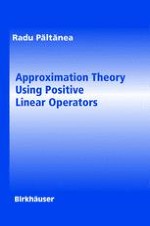2004 | Buch
Über dieses Buch
We deal in this work with quantitative results in the pointwise approximation of func tions by positive linear functionals and operators. One of the main objectives is to obtain estimates for the degree of approximation in terms of various types of second order moduli of continuity. In the category of sec ond order moduli we include both classical and newly introduced moduli. Particular attention is paid to optimizing the constants appearing in such estimates. In the last decades, the study of linear positive operators with the aid of second order moduli was intensive, thanks to their refinements in characterization of the smoothness of functions. As promoters of this direction of research we mention Yu. Brudnyi, G. Freud, and J. Petree. Our approach is more akin to the approach taken by H. Gonska, who obtained the first general estimates for second order moduli with precise constants and with free parameters. Two new methods will be presented. The first one, based on decomposition of functionals and the use of moments, can be applied to diverse types of moduli and leads to simple estimates. The second method gives sufficient conditions for obtaining absolute optimal constants. The benefits of these more direct methods, compared with the known method based on K-functionals, consist in the improvement and even the optimization of the constants, and in the generalization of the framework.
Anzeige
